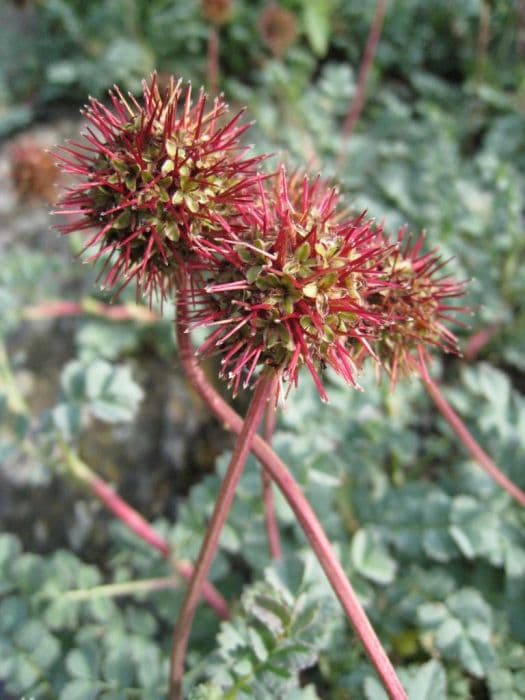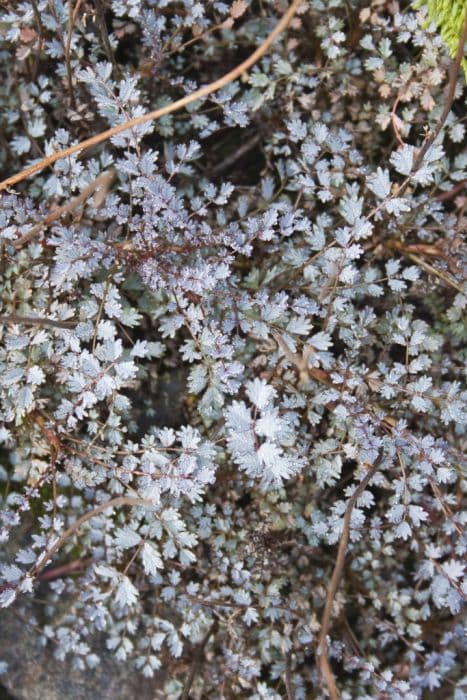Japanese quince 'Rowallane' Chaenomeles × superba 'Rowallane'

ABOUT
'Rowallane' is a small deciduous shrub of spreading habit, with obovate leaves to 6cm in length. Flowers 4cm in width, deep crimson are followed by apple-like, yellow fruits, fragrant when ripe
About this plant
 Names
NamesFamily
Rosaceae
Synonyms
Superb Flowering Quince, Rowallane Flowering Quince
Common names
Chaenomeles × superba 'Rowallane'.
 Characteristics
CharacteristicsLife cycle
Perennials
Foliage type
Deciduous
Color of leaves
Green
Flower color
Pink
Height
3 feet 0.91 meters
Spread
5 feet 1.52 meters
Plant type
Shrub
Hardiness zones
5
Native area
Asia
Benefits
 General Benefits
General Benefits- Ornamental Appeal: Flowering Quince provides vibrant blooms in spring, adding a splash of color to the garden.
- Wildlife Attraction: Its flowers attract pollinators, while fruits can attract birds.
- Low Maintenance: Once established, it requires minimal care, making it suitable for low-maintenance landscapes.
- Drought Tolerance: It can tolerate dry conditions, reducing the need for frequent watering.
- Adaptability: Flowering Quince is adaptable to a range of soil types, provided they are well-drained.
- Hedge or Barrier: Due to its dense growth, it can be used as a hedge or to create barriers in garden design.
- Longevity: This is a long-lived shrub that can provide many years of enjoyment with proper care.
 Medical Properties
Medical PropertiesThis plant is not used for medical purposes.
 Air-purifying Qualities
Air-purifying QualitiesThis plant is not specifically known for air purifying qualities.
 Other Uses
Other Uses- Flowering Quince branches can be used in floral arrangements to add a natural and rustic touch to the decor, especially when in bloom with their vibrant flowers.
- The thorny nature of Flowering Quince makes it a suitable natural barrier when planted in a hedge or along property lines to deter animals and unwanted encroachments.
- Used in bonsai culture, the Flowering Quince can be shaped and maintained as a miniature tree for artistic and decorative purposes.
- The dense growth and thorny branches of Flowering Quince can provide safe nesting sites for various species of birds in a garden setting.
- Fruit of the Flowering Quince can be utilized in crafting activities such as making natural dyes for fabrics or artistic work due to their vibrant color.
- Flowering Quince can be incorporated into wildlife gardens to attract pollinators like bees and butterflies, thereby promoting biodiversity.
- Fruits from Flowering Quince have been traditionally used to create pectin-rich jams and jellies, though they are not as commonly used today.
- The shrub can be utilized in erosion control, with its extensive root system helping to stabilize slopes and banks in landscapes.
- Flowering Quince's blossoms can be a source of nectar early in the season, providing an early food source for emerging pollinators.
- Its dramatic presence when in full bloom can be used to create striking natural photography backdrops for portraits or artistic photography.
Interesting Facts
 Feng Shui
Feng ShuiThe Flowering Quince is not used in Feng Shui practice.
 Zodiac Sign Compitability
Zodiac Sign CompitabilityThe Flowering Quince is not used in astrology practice.
 Plant Symbolism
Plant Symbolism- Optimism and Hope: As a flowering quince, Chaenomeles × superba 'Rowallane' blooms with vibrant flowers early in the spring, often when few other plants are in bloom. This symbolizes the optimism and hope that comes with the first signs of spring after a long winter.
- Renewal and Fresh Starts: The spring bloom of the flowering quince is also representative of renewal and fresh starts, as it coincides with the season of new beginnings and nature's resurgence.
- Perseverance: Hardy and resilient, Chaenomeles × superba 'Rowallane' can withstand challenging conditions. This resilience makes the plant a symbol of perseverance and the ability to overcome obstacles.
- Adoration and Attraction: With its stunning and eye-catching flowers, the flowering quince is often associated with adoration and can symbolize attraction or the beauty of someone beloved.
- Good Fortune: In some cultures, flowering quince plants like Chaenomeles × superba 'Rowallane' are thought to bring good luck and prosperity, especially around occasions like the Lunar New Year.
 Water
WaterThe Flowering Quince should be watered deeply to foster a healthy root system but it's important to let the soil dry out between waterings to prevent root rot. During the growing season, this might translate to watering once every week or two, providing about 1 to 1.5 gallons depending on the size of the plant and the weather conditions. In the winter, reduce watering frequency as the plant goes dormant. Adjustments should be made based on rainfall and temperature, always checking the soil moisture before watering again.
 Light
LightThe Flowering Quince thrives best in full sun to partial shade. Ideally, it should receive at least six hours of direct sunlight a day. It will perform well in a spot that receives morning sunlight and some afternoon shade or filtered light to protect it from the intense heat of the day.
 Temperature
TemperatureThe Flowering Quince is hardy and can withstand a range of temperatures, but ideally, it should be grown in an environment where temperatures stay between 50°F and 85°F. It can survive in temperatures as low as 0°F and can tolerate up to 100°F, although prolonged exposure to these extremes should be avoided to prevent stress to the plant.
 Pruning
PruningPrune the Flowering Quince immediately after flowering to maintain its shape and encourage the growth of flowers for the next season. Pruning is also necessary to remove any dead, damaged, or diseased branches. Thinning out overcrowded branches every few years will facilitate good air circulation, which helps prevent fungal diseases. The best time for major pruning is late winter or early spring, just before the new growth starts.
 Cleaning
CleaningAs needed
 Soil
SoilThe Flowering Quince 'Rowallane' thrives in a well-draining loamy soil mix, enhanced with organic matter such as compost or leaf mold. A slightly acidic to neutral pH balance, ranging from 6.0 to 7.0, is ideal for this plant.
 Repotting
RepottingThe Flowering Quince 'Rowallane' should generally be repotted every 2-3 years to refresh the soil and accommodate root growth, less frequently as it matures.
 Humidity & Misting
Humidity & MistingThe Flowering Quince 'Rowallane' prefers moderate humidity levels, typical of outdoor conditions, without the need for special humidity adjustments when grown in its natural environment.
 Suitable locations
Suitable locationsIndoor
Ensure bright light and cool winters for indoor Flowering Quince.
Outdoor
Plant in well-draining soil, full sun to part shade.
Hardiness zone
5-9 USDA
 Life cycle
Life cycleThe Superb Quince (Chaenomeles × superba 'Rowallane') begins its life cycle when a seed germinates, typically in spring, after experiencing cold stratification. The seedling emerges and, given suitable conditions of sunlight, water, and nutrient-rich soil, will establish roots and develop foliage. As it matures into a shrub, it undergoes a vigorous period of growth, forming a dense thicket of spiny branches that bear glossy green leaves. After a few years, the plant reaches maturity and begins to produce fragrant blossoms in shades of pink or red in early spring, before the leaves appear. Pollinated flowers will develop into small, apple-like fruit by the late summer or fall, which are generally not considered palatable for humans but can attract wildlife. Each year, the plant continues its cycle of blossoming and fruiting, and with adequate care, it can live for several decades.
 Propogation
PropogationPropogation time
Spring to early summer
The most popular method of propagation for the Flowering Quince 'Rowallane' is through softwood cuttings. This process is typically performed in late spring or early summer when new growth is still flexible yet mature enough to handle cutting and rooting. To propagate, gardeners will cut a 4-6 inch (10-15 cm) section of stem from the new growth. The lower leaves are removed, and the cut end is often dipped in rooting hormone to encourage root development. The prepared cutting is then placed in a well-draining soil mix and kept under high humidity and indirect light until roots have developed, which could take several weeks. Once the cutting has established a strong root system, it can be transplanted into a larger pot or directly into the garden.









